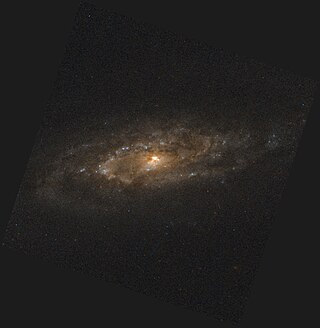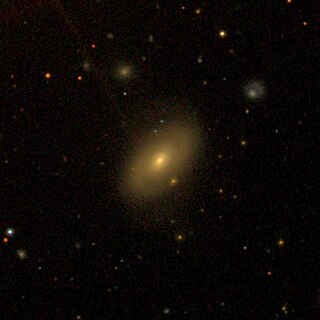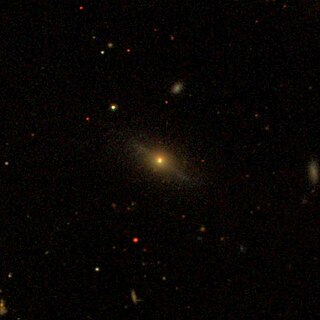
NGC 6946, sometimes referred to as the Fireworks Galaxy, is a face-on intermediate spiral galaxy with a small bright nucleus, whose location in the sky straddles the boundary between the northern constellations of Cepheus and Cygnus. Its distance from Earth is about 25.2 million light-years or 7.72 megaparsecs, similar to the distance of M101 in the constellation Ursa Major. Both were once considered to be part of the Local Group, but are now known to be among the dozen bright spiral galaxies near the Milky Way but beyond the confines of the Local Group. NGC 6946 lies within the Virgo Supercluster.

NGC 4395 is a nearby low surface brightness spiral galaxy located about 14 million light-years from Earth in the constellation Canes Venatici. The nucleus of NGC 4395 is active and the galaxy is classified as a Seyfert Type I known for its very low-mass supermassive black hole.

NGC 7537 is a spiral galaxy located in the equatorial constellation of Pisces, about 1.5° to the NNW of Gamma Piscium. It was first documented by German-born astronomer William Herschel on Aug 30, 1785. J. L. E. Dreyer described it as, "very faint, considerably small, round, brighter middle, southwestern of 2". This galaxy lies at a distance of approximately 127 Mly (39 Mpc) from the Milky Way, and is a member of the Pegasus I cluster.

NGC 1600 is an elliptical galaxy in the constellation Eridanus, 149 Mly (46 Mpc) away from Earth.

NGC 325 is a spiral galaxy located in the constellation Cetus. It was discovered on September 27, 1864 by Albert Marth. It was described by Dreyer as "very faint, very small".

NGC 328 is a spiral galaxy in the constellation Phoenix. It was discovered on 5 September 1836 by John Herschel. It was described by Dreyer as "very faint, a little extended, very gradually brighter middle, following (eastern) of 2", the other being NGC 323.

NGC 338 is a spiral galaxy in the constellation Pisces. It was discovered in 1877 by Wilhelm Tempel. It was described by Dreyer as "very faint, very small, irregular figure, brighter middle."

NGC 340 is a spiral galaxy in the constellation Cetus. It was discovered on September 27, 1864, by Albert Marth. It was described by Dreyer as "very faint, small, extended."

NGC 345 is a spiral galaxy located in the constellation Cetus. It was discovered on September 27, 1864 by Albert Marth. It was described by Dreyer as "very faint, very small, gradually brighter middle."

NGC 347 is a spiral galaxy in the constellation Cetus. It was discovered on September 27, 1864, by Albert Marth. It was described by Dreyer as "very faint, very small."

NGC 349 is a lenticular galaxy in the constellation Cetus. It was discovered on September 27, 1864 by Albert Marth. It was described by John Louis Emil Dreyer as "very faint, very small."

NGC 354 is a barred spiral galaxy in the constellation Pisces. It was discovered on October 24, 1881 by Édouard Stephan. It was described by Dreyer as "very faint, very small, round, very small (faint) star involved, 14th magnitude star close to west."

NGC 355 is a lenticular galaxy in the constellation Cetus. It was discovered on September 27, 1864 by Albert Marth. It was described by Dreyer as "extremely faint, very small."

NGC 356 is a spiral galaxy in the constellation Cetus. It was discovered on September 27, 1864 by Albert Marth. It was described by Dreyer as "very faint, small, irregularly round."

NGC 361 is an open cluster in the Small Magellanic Cloud. It is located in the constellation Tucana. It was discovered on September 6, 1826 by James Dunlop. It was described by Dreyer as "very very faint, pretty large, very little extended, very gradually brighter middle." At an aperture of 31.0 arcseconds, its apparent V-band magnitude is 12.24, but at this wavelength, it has 0.40 magnitudes of interstellar extinction.

NGC 364 is a barred lenticular galaxy in the constellation Cetus. It was discovered on September 2, 1864 by Albert Marth. It was described by Dreyer as "very faint, very small."

NGC 373 is an elliptical galaxy located in the constellation Pisces. It was discovered on December 12, 1876 by John Louis Emil Dreyer. It was described by Dreyer as "very faint, very small."

NGC 407 is an edge-on spiral or lenticular galaxy located in the constellation Pisces. It was discovered on September 12, 1784 by William Herschel. It was described by Dreyer as "very faint, very small, southwestern of 2.", the other being NGC 410.

NGC 429 is a lenticular galaxy of type S0^0: located in the constellation Cetus. It was discovered on December 20, 1786 by William Herschel. It was described by Dreyer as "very faint, very small."

NGC 445 is a peculiar lenticular galaxy located in the constellation of Cetus. It was discovered on October 23, 1864, by Albert Marth. It was described by Dreyer as "very faint, very small."




















